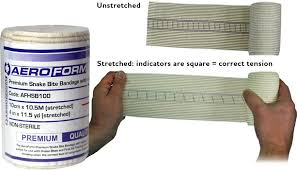Learn how to apply a pressure immobilisation bandage in snake bite First aid training Ballina
 First aid classes in Ballina can show you how to use a pressure immobilisation bandage as the recommended technique for managing snakebites, especially in cases where the snake is venomous. The use of indicator bandages in first aid training makes it easier for students to learn how to apply the correct pressure over the limb. The goal is to slow the spread of venom through the lymphatic system. Here are the steps to use a pressure immobilisation bandage for snakebites:
First aid classes in Ballina can show you how to use a pressure immobilisation bandage as the recommended technique for managing snakebites, especially in cases where the snake is venomous. The use of indicator bandages in first aid training makes it easier for students to learn how to apply the correct pressure over the limb. The goal is to slow the spread of venom through the lymphatic system. Here are the steps to use a pressure immobilisation bandage for snakebites:
-
Stay Calm: Remain as calm as possible to help the victim stay calm as well. Panic can increase heart rate and potentially speed up the spread of venom.
-
Call for Help: Dial emergency services (e.g., 000 in Australia) immediately to request professional medical assistance. The bandage is not a substitute for medical treatment; it is a temporary measure to slow venom spread.
-
Immobilise the Victim: Ensure the victim is lying down with the bitten limb immobilised. Keep them as still as possible.
-
Expose the Bite Area: Gently remove any tight clothing or jewellery near the bite site, as swelling can occur.
-
Apply a Pressure Immobilisation Bandage:
- Use a wide, elastic bandage (ideally 10-15 cm or 4-6 inches wide) or a purpose-made snakebite bandage if available. If you don’t have a purpose-made bandage, any elastic bandage will do.
- Starting a few inches above the bite site, firmly wrap the bandage towards the heart. The idea is to create even pressure around the limb.
- Continue wrapping the bandage down the limb, covering the entire limb, including the bite site. Be careful not to make it too tight, as this could cause other issues.
-
Mark the Bite Site: If possible, mark the location of the snakebite on the bandage with a pen or make a note of the time of the bite. This can help medical professionals.
-
Splint the Limb: Once the bandage is applied, immobilise the limb by splinting it. You can use a rigid object (e.g., a stick or rolled-up newspaper) alongside the limb and secure it with another bandage or cloth.
-
Elevate the Limb: If possible and without causing pain or discomfort to the victim, slightly elevate the affected limb.
-
Monitor the Victim: Keep a close eye on the victim’s vital signs, such as their pulse and breathing rate. Be prepared to perform CPR if necessary.
-
Stay Calm: Reiterate the importance of remaining calm and still. Encourage the victim to avoid using the limb.
Remember that the pressure immobilisation bandage is a temporary measure to slow the spread of venom, and the victim still needs immediate medical attention. The bandage should not be so tight that it cuts off circulation or causes further harm. Ensure that you do not delay seeking professional medical help, as antivenom may be necessary to treat the snakebite effectively.
You can book a first aid course in Ballina online to learn how to treat snakebite

